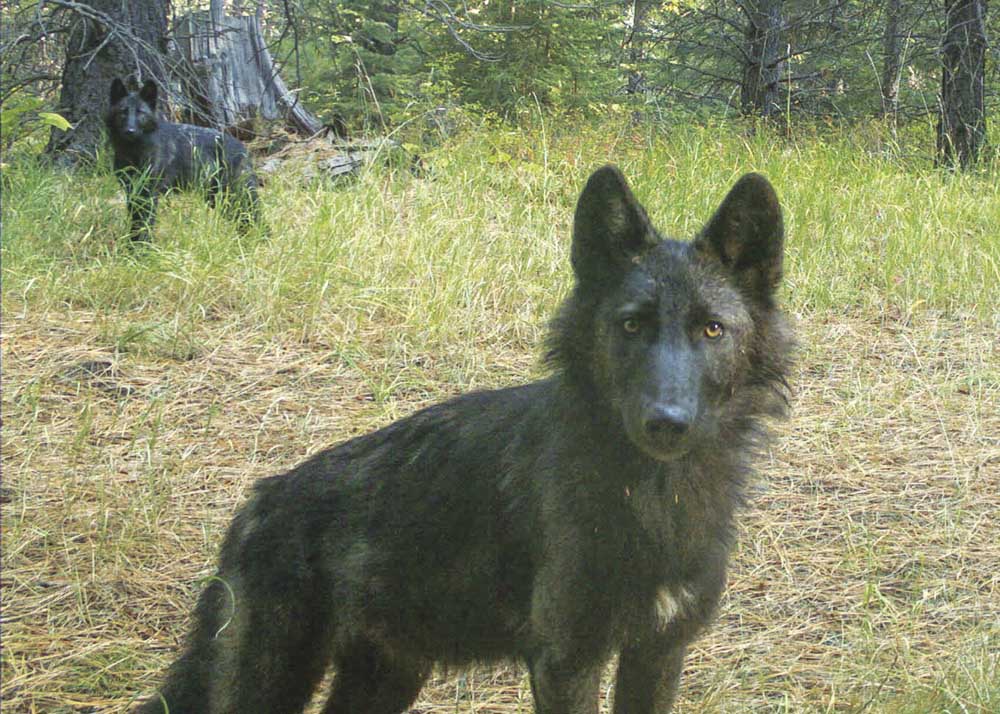Oregon wolf population holds steady
Published 12:00 pm Tuesday, April 23, 2024

- A remote camera captured an image of two 5-month-old juvenile wolves of the Wenaha pack on Forest Service lands in northern Wallowa County in September 2020.
Oregon’s wolf population grew slightly in 2023, but the capture and transplant of 10 wolves from Northeast Oregon to Colorado in mid-December offset that increase.
The Oregon Department of Fish and Wildlife counted 178 wolves statewide — about 75% in the northeast corner — at the end of 2023.
That’s the same total as the count in the waning days of 2022.
But the count of 178 wolves doesn’t include the 10 that were captured and taken to Colorado.
Although the figures are the actual numbers of wolves that ODFW biologists counted during the annual census each year, and not an estimate, the agency notes that there are more wolves in the state than the official total.
“These counts are conducted in the winter and not all wolves are located, so the actual number of wolves in Oregon is higher than this minimum count,” according to the annual wolf report, which was released on April 12.
Much higher, said John Williams, who lives in Wallowa County and is Eastern Oregon co-chairman of the Oregon Cattlemen’s Association’s wolf committee.
“There’s a lot more wolves in Oregon than the 178 minimum count. That’s not even in the ballpark,” Williams said Thursday, April 18. “As the wolves have expanded across Oregon, they don’t have the resources to count them all.”
Williams also said ODFW’s census showed 62 wolves just in Wallowa County — and that’s without including wolves from the Grouse Flats pack, which moves between Washington state and Wallowa County.
Todd Nash, a Wallowa County commissioner and immediate past president of the cattlemen’s association, believes ODFW’s wolf survey has a basic flaw.
“We’ve heard from people who have seen 20 wolves within a few miles’ radius,” Nash said.
Both Williams and Nash said they opposed ODFW sending the 10 wolves to Colorado.
“We don’t support moving wolves from one area to expand the problem to ranchers in another area,” Williams said. “Those 10 wolves have already depredated in Colorado.”
Little change over past four years
The annual count has changed little, if at all, the past three years. The 2020 count was 173. The number grew by two wolves in 2021 before stabilizing at 178 the next two years.
That stable trend follows significant growth in wolf numbers over the previous decade or so.
The year-end census turned up 29 wolves in 2011.
Oregon’s wolf population grew by more than fivefold over the subsequent decade. Annual increases included 59% in 2012, 39% in 2013, 20% in 2014 and 43% in 2015.
Although wolf numbers have increased in the Cascade Mountains and parts of Southern and Western Oregon, a large majority of the state’s wolves live in the northeast corner. That’s been the case since the first confirmed wolf moved into Baker County from Idaho in 1999.
Wolf attacks on livestock
Northeast Oregon remained the focal point for wolf attacks on livestock in 2023.
ODFW confirmed 62 attacks in the eastern part of the state, a 27% increase from 2022 that happened “despite extensive use of non-lethal deterrents,” according to the annual wolf report.
“Parts of Northeast Oregon remain livestock depredation hotspots, and managing wolf-livestock conflict continues to be challenging,” the report states.
“Reducing the burden on landowners and producers remains critical for the long-term conservation of wolves in Oregon,” said Roblyn Brown, ODFW wolf coordinator.
Nash contends that the rise in depredations in Northeast Oregon is evidence that wolf numbers are rising regardless of ODFW’s census.
“Wherever there’s wolves, there’s depredation,” he said. “Eventually they’re going to find livestock to feed on.”
Nash pointed out that of the $477,000 the Oregon Department of Agriculture awarded in 2023 to 11 counties, including Baker, Wallowa, Union and Grant, for compensation related to wolf depredation, 84% was used for nonlethal deterrents.
Some of the tactics, such as removing or burying livestock carcasses to avoid attracting wolves, can be effective.
But when cattle are grazing on summer forest allotments, nonlethal tactics are less effective, Nash said.
“We’re only required to use 30% for nonlethal,” he said. “But sometimes we’ve depleted that and still have guys with missing livestock. We need to be conscious about how we use those funds in the future.”
The increase in wolf attacks in Northeast Oregon offset a decline on the west side of the state, where depredations dropped from 27 in 2022 to 11 in 2023.
Statewide, wolf attacks dropped from 76 in 2022 to 73 in 2023.
In confirmed attacks, wolves killed 16 cows, 40 calves, eight sheep and two working dogs. Wolves also injured eight cows, 17 calves and two sheep.
Of the wolf attacks on livestock in 2023, 84% happened on private property, according to ODFW.
Christina Witham, a Baker County commissioner, said wolf attacks on livestock is the main topic that prompts her constituents to talk with her about wolves in the county.
One of the larger incidents of wolf depredations on livestock happened on the Jacobs ranch about 15 miles northeast of Baker City where wolves from the Keating pack killed eight sheep and injured two others over about a week in mid-October 2023.
In one instance, dead sheep were found within 500 yards of four homes. Another carcass was less than 100 yards from two homes.
The ranch owners used a variety of tactics to deter wolves, including deploying large guard dogs and installing strobe lights.
Wolves east of a line formed by Highways 395, 78 and 95 are not protected under the federal Endangered Species Act. ODFW is responsible for managing wolves in that area, and under the state wolf plan the agency can issue kill permits to livestock owners, or their agents, in cases when ODFW biologists confirm that a wolf pack has attacked livestock at least twice in in a given area within nine months and if the rancher has been using nonlethal tactics to try to discourage wolves.
In 2023, ODFW received requests for kill permits for nine wolf packs or groups.
Sixteen wolves were killed under such permits, half of those from the Black Pines pack, which attacked and killed livestock multiple times near the border of Baker and Union counties in the Medical Springs area.
Other wolves killed include four from the Five Points pack northeast of La Grande, two from the Wildcat pack in Wallowa County, one from the Lookout Mountain area east of Baker City, and one from the Grouse Flats pack, which ranges between Washington state and Wallowa County.
Overall, 36 wolves died in Oregon in 2023 — 30 of those in Eastern Oregon — up from 20 in 2022, according to ODFW.
In addition to the 16 wolves killed under a permit, four were hit by a car. The cause of death is not known for two wolves, one from the Keating pack northeast of Baker City and one from the Balloon Tree pack north of Elgin. The breeding female from the Wenaha pack in Wallowa County died of bone cancer.
Oregon State Police is investigating the deaths of eight wolves, all in Northeast Oregon. Seven of the wolves were poisoned and one, from the Cornucopia group in Baker County, was shot.
Of the poisoned wolves, two were from the Keating pack, two from either the Walla Walla or Noregaard packs, one from the Finley Ridge pack, one from the Chesnimnus pack, and a dispersing wolf from Washington state near the same location in Wallowa County.
Wolf advocates say animals face ‘toxic mix’
Several groups that want Oregon’s wolf population to increase expressed concern about the nearly flat trend of the past four years.
They called on ODFW to stop issuing kill permits.
“Oregon is facing a toxic mix of threats to our wolf population: a poaching epidemic and unreasonably high levels of agency authorized killings,” said Bethany Cotton, conservation director with Cascadia Wildlands. “To ensure Oregon meets our wolf conservation and recovery goals, we need to rein in both poaching and agency-approved killings. ODFW needs to do more to protect Oregon’s small wolf population. The agency can start by not being one of the two primary causes of the population’s failure to grow. Until poaching is brought under control and Oregon’s wolf population increases for several years, the agency needs to stop authorizing wolf killings and concentrate on implementing proven effective coexistence tools.”
On April 8, just four days before ODFW released the wolf report, four environmental groups, including the Sierra Club, filed a federal lawsuit seeking to have wolves in the Northern Rocky Mountains region, which includes Eastern Oregon, protected under the Endangered Species Act.
The federal government removed that population of wolves from the Endangered Species Act in 2011. Wolves remain under federal protection in Oregon west of Highways 395, 78 and 95.
U.S. Rep. Cliff Bentz, the Ontario Republican who represents the 2nd Congressional District, which includes most of Oregon east of the Cascades, has called for the U.S. Fish and Wildlife Service to remove wolves across Oregon, including west of those three highways, from federal protection.
During a public meeting April 4 at the Pendleton Convention Center, Bentz, who is chairman of the Water, Wildlife and Fisheries subcommittee, called wolves “cold killers.”
Wolf monitoring
By the end of 2023, ODFW was monitoring the movements of 26 wolves that have tracking collars.
Two ODFW biologists coordinate the statewide wolf program from the agency’s East Region office in La Grande. The agency also has three regional wolf biologists, one each at the Enterprise, Prineville and Central Point offices.
Oregon wolf population*
The minimum Oregon wolf population based on census done in December each year.
2023: 178
2022: 178
2021: 175
2020: 173
2019: 158
2018: 137
2017: 124
2016: 112
2015: 110
2014: 77
2013: 64
2012: 46
2011: 29
*Oregon Department of Fish and Wildlife says this is the minimum population, and that there is an unknown number of wolves not counted during the annual census.
“Oregon is facing a toxic mix of threats to our wolf population: a poaching epidemic and unreasonably high levels of
agency authorized killings.”
— Bethany Cotton, conservation director, Cascadia Wildlands
“There’s a lot more wolves in Oregon than the 178 minimum count. That’s not even in the ballpark As the wolves have expanded across Oregon, they don’t have the resources to count them all.”
— John Williams, co-chairman, Oregon Cattlemen’s Association wolf committee





